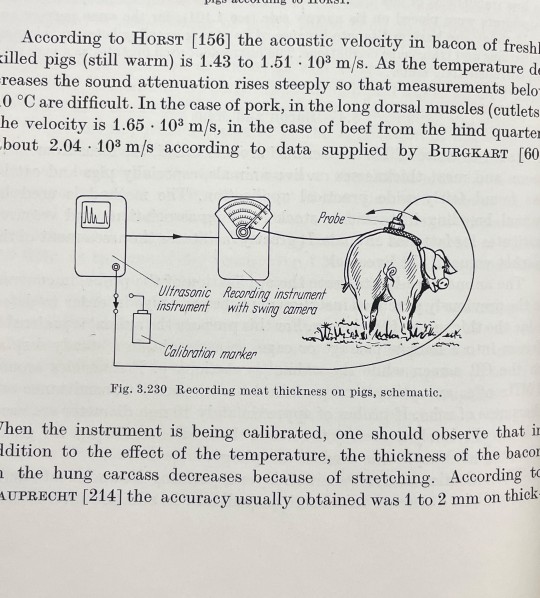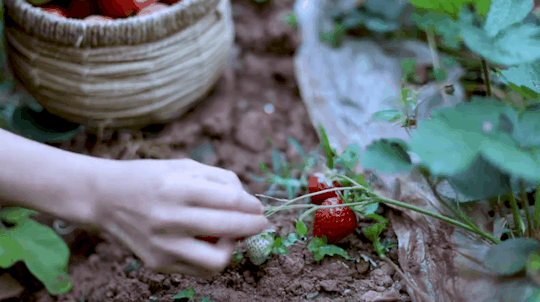#Agricultural Science
Explore tagged Tumblr posts
Text
Tea Chem 101: L-Theanine! What is it, why is it good for you, and how heckin delish is it? 🍵🧬
In my bowl: Sugimoto Estate Ceremonial Matcha
#tea#tea geek#phytochemicals#botany#agriculture#agricultural science#chemistry#plants#plant science#matcha#l-theanine
9 notes
·
View notes
Text
Selective Breeding of Brassicas

Patreon
#studyblr#notes#biology#bio#bio notes#biology notes#plant science#science#botany#botany notes#gardening#selective breeding#domestication#plant domestication#agriculture#agricultural science#plant science notes#ecology#environmental science#scienceblr#sciblr#garden plants#garden herbs#genetics#genetics notes#use of genetics
4 notes
·
View notes
Text

This illustration of an ultrasonic reading device to measure the fat in pigs for bacon is JUST SO WIERD.
Ultrasonic testing of materials, 1969.
25 notes
·
View notes
Text
Baby nasturtium leaves are too stinkin CUTE!!!

Nasturtiums are a beautiful, EDIBLE vining flower. They have bright orange flowers that look kinda like large pansies, with a bright peppery taste to match. They're a tasty garnish in salads, sandwiches, soups, etc!
If that's not enough, they're also great at repelling pests in the garden, so they're best planted as companions around your crops!
#botanical science#earth science#gardening#agricultural science#grow your own food#plant science#horticultural science#plant biology#permaculture#veggies#flower#nasturtium#pest control#garden facts#garden tips#seedling#spring#companion planting#plants
19 notes
·
View notes
Text

2 notes
·
View notes
Text
Agricultural Science, Middle School
Do Now:
Watch the video and keep track of the useful/useless ideas
Actually Useful:
Possibly Useful:
Complete Garbage:
#do now#middle school#agricultural Science#I went from huh? to huh??? to straight up laughing#oh no! aves!#if only they had plastic wrap during Birdemic
2K notes
·
View notes
Text
Job - Alert 🌱

🌾 Join Universität für Bodenkultur Wien as a Full Professor of Agricultural Systems Engineering! 🌾
The University of Natural Resources and Life Sciences, Vienna (BOKU) invites applications for a Full Professor position starting October 1, 2025. This role is part of the Department of Agricultural Sciences, focusing on sustainable agricultural systems.
📅 Application Deadline: March 20, 2025
📧 Apply now: https://www.academiceurope.com/job/?id=6666
We look forward to your application!
#hiring#jobs#science#jobseekers#professor#agricultural science#engineering#plant science#life science#systemsengineering#soil science
0 notes
Text
How Does Plant Breeding Work? And What Are F1 Hybrids?
Plant breeding is an age-old science, deeply rooted in the quest to enhance crop quality, yield, and resilience. Whether you’re a farmer aiming to improve your harvest or a curious gardener fascinated by the diversity of plant varieties, understanding how plant breeding works—and what F1 hybrids are—offers a glimpse into the fascinating world of agricultural innovation. Let’s break it down step…
#Agricultural Innovation#agricultural science#crop improvement#F1 hybrids#F2 hybrids#farming practices#genetic diversity#heterosis effect#hybrid plants#hybrid seeds#hybrid vigor#hybridization#Plant Breeding#plant breeding process#plant genetics#pure line varieties#seed propagation#seed selection#sustainable farming#vegetable breeding
1 note
·
View note
Text

ABOUT THIS BLOG ! :3
What is this blog about?
This blog is a project for my agricultural science class! On this blog, I will post drawings I make that are like information posters on numerous topics regarding nature and agriculture. Some examples would be how to grow certain plants, what you can do with different fruits and vegetables alongside how to grow them, information on animals and more! I’ve always had a passion for art and wanted to be more active on Tumblr, so I’m very glad I get such an opportunity to post my art and I’m very grateful for my teacher for allowing this.
ANY NEGATIVE COMMENTS ON MY ART OR POSTS WILL RESULT IN A BLOCK AND REMOVAL OF YOUR COMMENT.
* P.S ; I’ve included a requests box in case you wanna learn about a certain animal, plant, fruit or anything agriculture related!
Who runs this blog?
I do! I go by Chlaudie ScKies on this blog since she’s is the mascot I created. I am in my final year of middle school and trying to make the best of it! I use they/she pronouns. My hobbies include cooking, drawing, swimming, researching on various topics and more! My favorite thing to cook is anything with pasta, but I am a picky eater! My favorite artists are Mitski, Rio Romeo, Mommy Long Legs and MCR. I hope to make some friends on here and for my blog to grow a bit! If you have any questions regarding this blog, shoot me a message!
Chlaudie ScKies
This is just some information on the mascot of this blog!
Chlaudie is a 12-year-old gardener who’s homeschooled! She is Mexican and Peruvian with very tight curls. She’s very curious and bubbly! Her name is a pun because she loves the rain!

#agriculture#chlaudie sckies#art project#school project#intro post#introduction#agricultural science#traditional art#artwork#art#artists on tumblr#my art#oc art#school work#school#tumblr girls#female artists#artist support#women artists
1 note
·
View note
Text
Characteristics of Climate of Zambia
This post touches and discusses the topic on the Climate of Zambia, including the seasons, rainfall activities and effect of altitude on the climate. Climate of Zambia Zambia’s tropical climate Zambia lies in the tropical areas near the equator, and therefore has a tropical climate. A tropical climate has the following characteristics: • Summers have high temperature and rainfalls in the…

View On WordPress
0 notes
Text
#science#science communication#scicomm#stem#science education#science blog#environmental science#Farming#women in science#women in stem#feminism#agriculture#Agricultural science
0 notes
Text
Why India’s Green Revolution isn’t a blueprint to feed a hungry planet
Feeding a growing world population has been a serious concern for decades, but today there are new causes for alarm. Floods, heat waves and other weather extremes are making agriculture increasingly precarious, especially in the Global South. The war in Ukraine is also a factor. Russia is blockading Ukrainian grain exports, and fertilizer prices have surged because of trade sanctions on Russia,…

View On WordPress
#agricultural science#agriculture news#food crisis#Green revolution#green revolution analysis#green revolution in 1960s#Green revolution in india#M.S. Swaminathan#science#was the green revolution fruitful
0 notes
Text
Trump may be about to sign the death sentence of the National Institute of Health, and, by extension, the Office of Lab Animal Welfare.
He gutted research animal protections.
Any vertebrate that isn't a mammal will have no rights.
Neither will mice or rats.
If NIH grants are stopped, researchers can't pay anyone. They can't perform research. They can't pay for veterinary services.
They won't be required to provide veterinary services.
The only medical research that will happen will be self funded by big pharma, and they can torture the animals and skew all the lab results that they want.
Just like Musk did to the primates in his neuralink research.
I don't know what's going to happen to me or anyone else at the university where I work. My job is to make sure the animals are treated humanely and to provide veterinary care. I'm especially scared about what's going to happen to those research animals if veterinary staff gets laid off. The USDA only covers mammals, and it doesn't even cover all of them. Every rat I've ever made a tiny paper gift box full of marshmallows for, every mouse I've ever watched grow up, every rodent I've ever separated from an aggressive dominant brother and then treated their tiny wounds, they have no protections if NIH goes down. Decades of research into humane handling, euthanasia, and animal behavior will be tossed aside and wasted.
Please, do everything you can. Protest. Contact your representatives. Anything you can do. Do it for science, for medicine, for people's lives, for people's jobs, and for the animals.
#nih#cdc#us politics#national institutes of health#research#department of health and human services#public health#donald trump#OLAW#office of lab animal welfare#usda#us department of agriculture#animal rights#animal care#animal health#science#cancer research#disease research#public health service#elon musk#presidential election of 2024#fuck elon#fuck trump#president trump#trump 2024#dump trump#infectious diseases#animal welfare#animal welfare regulations#mouseblr
1K notes
·
View notes
Text
ASC2023: 16वें कृषि विज्ञान कांग्रेस का होने जा रहा है आयोजन, जानिए कहां करें रजिस्ट्रेशन
इस बार क्या है 16वें कृषि विज्ञान कांग्रेस की थीम और क्या है ख़ास?
कृषि विज्ञान कांग्रेस का लक्ष्य दुनिया भर के प्रमुख शिक्षाविदों, शोधकर्ताओं, छात्रों, किसानों, उद्यमियों जैसे वर्गों को एक साथ लाना है। ताकि वो कृषि-खाद्य प्रणालियों के सभी विषयों पर अपने शोध निष्कर्षों, विचारों और अनुभवों का एक दूसरे के साथ साझा कर सकें।

16वां कृषि विज्ञान कांग्रेस (ASC) 10 से 13 अक्टूबर 2023 तक कोची में आयोजित होगा। राष्ट्रीय कृषि विज्ञान अकादमी (National Academy of Agricultural Sciences), नई दिल्ली की ओर से ये कार्यक्रम आयोजित किया जाएगा। इसकी मेज़बानी भारतीय कृषि अनुसंधान परिषद्-केंद्रीय समुद्री मात्स्यिकी अनुसंधान संस्थान (ICAR-CMFRI) करेगा। इस बार कृषि विज्ञान कांग्रेस की थीम “सतत विकास लक्ष्यों (SDG) को प्राप्त करने के लिए कृषि-खाद्य प्रणालियों का परिवर्तन” पर केंद्रित है।
कृषि विज्ञान कांग्रेस का क्या है लक्ष्य?
कृषि विज्ञान कांग्रेस का लक्ष्य दुनिया भर के प्रमुख शिक्षाविदों, शोधकर्ताओं, छात्रों, किसानों, उद्यमियों जैसे वर्गों को एक साथ लाना है। ताकि वो कृषि-खाद्य प्रणालियों के सभी विषयों पर अपने शोध निष्कर्षों, विचारों और अनुभवों का एक दूसरे के साथ साझा कर सकें।
इन्हीं सभी बातों को ध्यान में रखते हुए कृषि विज्ञान कांग्रेस में प्रतिनिधियों और प्रतिभागियों को कृषि और उससे जुड़े सभी विषयों के मुद्दों जैसे भूमि और पानी की स्थिरता, कृषि उत्पादन प्रणालियों, उत्पादों, कृषि मशीनरी, अर्थशास्त्र, नवीकरणीय और वैकल्पिक ऊर्जा, प्रिसिजन फार्मिंग, वैकल्पिक खेती प्रणाली, तटीय कृषि, आने वाली पीढ़ियों में प्रौद्योगिकियां जैसे विषयों पर अपने विचारों को रखने के लिए पर्याप्त अवसर दिया जाएगा।
इन विषयों पर होगी मुख्य चर्चा:
खाद्य एवं पोषण सुरक्षा सुनिश्चित करना: उत्पादन, उपभोग और मूल्यवर्धन
टिकाऊ कृषि-खाद्य प्रणालियों के लिए जलवायु कार्रवाई
सीमांत विज्ञान और उभरती आनुवंशिक प्रौद्योगिकियाँ: जीनोम प्रजनन, जीन संपादन
खाद्य प्रणालियों का पशुधन आधारित परिवर्तन
खाद्य प्रणालियों का बागवानी आधारित परिवर्तन
जलीय कृषि एवं मत्स्य पालन आधारित खाद्य प्रणालियों का परिवर्तन
सतत कृषि-खाद्य प्रणालियों के लिए प्रकृति-आधारित समाधान
अगली पीढ़ी की प्रौद्योगिकियाँ: डिजिटल कृषि, सटीक खेती ��र एआई-आधारित प्रणालियाँ
कृषि-खाद्य प्रणालियों को बदलने के लिए नीतियां और संस्थान
अनुसंधान, शिक्षा और विकास के लिए अंतर्राष्ट्रीय भागीदारी
और पढ़ें.....
#16th agricultural science congress#agricultural science#asc expo#asc2023#कृषि विज्ञान#कृषि विज्ञान कांग्रेस
0 notes
Text
The Food Sovereignty Revolution, Right Down the Street

Lemme get on a soapbox really quick about Community Gardens. Because home farms are one thing, local farms are one thing, but nothing can bring people together and inspire confidence like a community garden.
Starting to grow your own food can be a daunting task, with a lot of conflicting information, and it can be difficult when you don’t have the land you need. Having an accessible area for people of all walks of life to come together and experience the trials of food growing makes it easier to inspire people to overcome the learning curve.
I found a nice resource in finding local community gardens by you if you'd like to participate this summer. I also HIGHLY recommend reaching out to anyone you know from Churches, Parks, Schools, Recreation Centers, and other public spaces, and ask them if gardens can be added to their possible developments. I have a few resources on my website for the importance of these gardens if you want to learn more, or send them to people you are trying to convince. It is extremely important that people understand how beneficial this can be for themselves, and their people.
#community garden#garden#gardening#agriculture#agricultural science#farming#farm#community#environmental science#environment#green spaces#green space#solar punk#green revolution#biodiversity#biology#garden blog#plants#sociology#botanical science#earth science#grow your own food#plant science#horticultural science#plant biology#permaculture#veggies
8 notes
·
View notes
Text
LC ag. science: calf production notes

1 note
·
View note